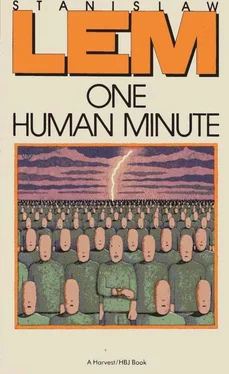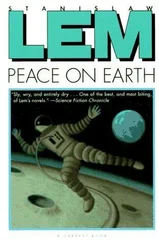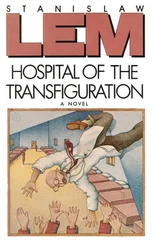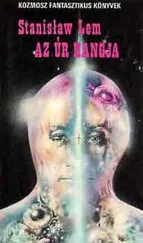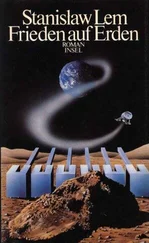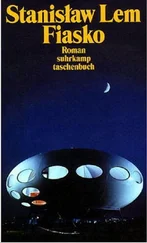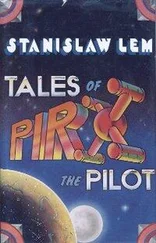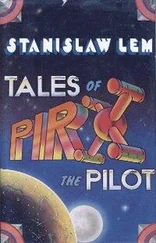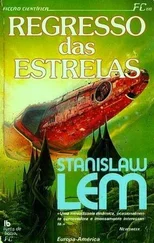My dilemma was how to hide the secret forever but at the same time take advantage of it freely — to hide it from the world but not from myself. After much deliberation, I realized that this could be done very easily. The safest way to conceal a remarkable idea — every word of it true — was to publish it as science fiction. Just as a diamond thrown on a heap of broken glass would become invisible, so an authentic revelation placed amid the stupidities of science fiction would take on their coloration — and cease to be dangerous.
At first, however, still fearful, I made a very modest use of the secret I possessed. In 1967 I wrote a science-fiction novel entitled His Master’s Voice (published in English in 1983 by Harcourt Brace Jovanovich). On page 125 of that edition, third line from the top, are the words “the ruling doctrine was… ‘indirect economic attrition,’” and then the doctrine is expressed by the aphorism “The thin starve before the fat lose weight."
The doctrine expressed publicly in the United States in 1980 — thirteen years after the original edition of His Master’s Voice — was put a little differently. (In the West German press they used the slogan “ den Gegner totrüsten” — “arm the enemy to death.")
Once I had confirmed — and there had been time enough to do so, after all, since the book’s appearance — that no one had noticed how my “fantasizing” agreed with later political developments, I grew bolder. I understood that truth, when set in fiction, is camouflaged perfectly, and that even this fact can be safely confessed. For that matter, no one takes anything seriously if it’s published. So the best way to keep a top secret secret is to put it out in a mass edition.
Having ensured the safety of my secret thus, I can now serenely set about giving a complete report. I will confine myself to the first two volumes of Weapons Systems of the Twenty-first Century: The Upside-down Evolution, published in 2105. I could even name the authors (none of whom has been born yet), but what would be the point? The work is in three volumes. The first presents the development of weapons from the year 1944; the second explains how the nuclear-arms race gave rise to the “unhumanizing” of warfare by transferring the production of weapons from the defense industry to the battlefield itself; and the third deals with the effect this greatest military revolution had on the subsequent history of the world.
Soon after the destruction of Hiroshima and Nagasaki, American nuclear researchers founded the Bulletin of the Atomic Scientists. On its cover they put the picture of a clock with the minute hand at ten to midnight. Six years later, after the first successful tests of the hydrogen bomb, they moved the hand five minutes closer, and when the Soviet Union acquired thermonuclear weapons the hand was moved three minutes closer. The next move would mean the end of civilization. The Bulletin’s doctrine was “One World or None": the world would either unite and be saved, or would perish.
With the nuclear build-up on both sides of the ocean and the placing of ever larger payloads of plutonium and tritium in ever more accurate ballistic missiles, none of the scientists who were the “fathers of the bomb” believed that peace — troubled as it was by local, conventional wars — would last to the end of the century. Atomic weapons had amended Clausewitz’s famous definition ("War is… a continuation of political activity by other means"), because now the threat of attack could substitute for the attack itself. Thus came about the doctrine of symmetrical deterrence known later as the “balance of terror.” Different American administrations advocated it with different initials. There was, for example, MAD (Mutual Assured Destruction), based on the “second-strike” principle (the ability of the country attacked to retaliate in force). The vocabulary of destruction was enriched in the next decades. There was “Total Strategic Exchange,” meaning all-out nuclear war; MIRV (Multiple Independently Targetable Re-entry Vehicle), a missile firing a number of warheads simultaneously, each aimed at a different target; PENAID (Penetration Aids), dummy missiles to fool the opponent’s radar; and MARY (Maneuverable Re-entry), a missile capable of evading antimissiles and of hitting the target within fifty feet of the programmed “ground zero.” But to list even a hundredth of the succession of specialized terms is impossible here.
Although the danger of atomic warfare increased whenever “equality” was lessened, and therefore the rational thing would seem to have been to preserve that equality under multinational supervision, the antagonists did not reach an agreement despite repeated negotiations.
There were many reasons, which the authors of Weapons Systems divide into two groups. In the first group they see the pressure of traditional thinking in international politics. Tradition has determined that one should call for peace but prepare for war, upsetting the existing balance until the upper hand is gained. The second group of reasons are factors independent of human thought both political and nonpolitical; these have to do with the evolution of the major applied military technologies.
Each new possibility of technological improvement in weaponry became a reality, on the principle “If we don’t do it, they will.” Meanwhile, the doctrine of nuclear warfare went through changes. At one time it advocated a limited exchange of nuclear strikes (though no one knew exactly what the guarantee of the limitation would be); at another, its goal was the total annihilation of the enemy (all of whose population became “hostages” of a sort); at still another, it gave first priority to destroying the enemy’s military-industrial potential.
The ancient law of “sword and shield” still held sway in the evolution of weaponry. The shield took the form of hardening the silos that housed the missiles, while the sword to pierce the shield involved making the missiles increasingly accurate and, later, providing them with self-guidance systems and self-maneuverability. For atomic submarines the shield was the ocean; improved methods for their underwater detection constituted the sword.
Technological progress in defense sent electronic “eyes” into orbit, creating a high frontier of global reconnaissance able to spot missiles at the moment of launch. This was the shield that the new type of sword — the “killer satellite" — was to break, with a laser to blind the defending “eyes,” or with a lightninglike discharge of immense power to destroy the missiles themselves during their flight above the atmosphere.
But the hundreds of billions of dollars invested in building these higher and higher levels of conflict failed, ultimately, to produce any definite, and therefore valuable, strategic advantage — and for two very different, almost unrelated reasons.
In the first place, all these improvements and innovations, instead of increasing strategic security, offensive or defensive, only reduced it. Security was reduced because the global system of each superpower grew more and more complex, composed of an increasing number of different subsystems on land, sea, and air and in space. Military success required infallible communications to guarantee the optimum synchronization of operations. But all systems that are highly complex, whether they be industrial or military, biological or technological, whether they process information or raw material, are prone to breakdown, to a degree mathematically proportional to the number of elements that make up the system. Progress in military technology carried with it a unique paradox: the more sophisticated the weapon it produced, the greater was the role of chance (which could not be calculated) in the weapon’s successful use.
Читать дальше
